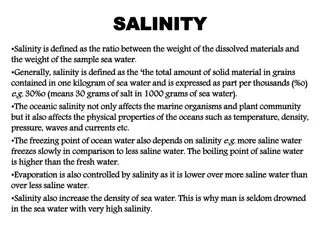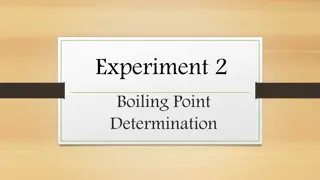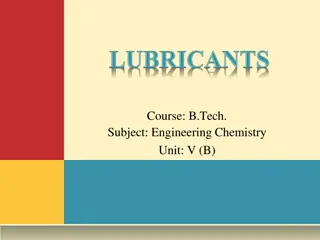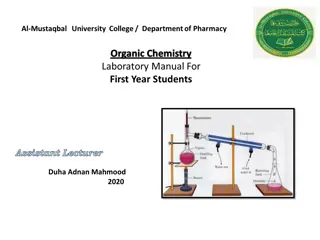Water Purification Methods and Techniques Explained
Explore the purification of water on both large and small scales, including storage, filtration, and disinfection processes. Learn about different methods such as boiling, chemical disinfection, and filtration for household water purification. Discover the importance of treatment based on the nature
4 views • 66 slides
Understanding the 3-Massecuite Boiling System in Sugar Processing
The process of pan boiling in sugar processing involves multiple gradations of massecuite to ensure high sugar quality and recovery. By separating crystals from mother liquor and boiling in stages, the 3-massecuite system optimizes sugar production while minimizing losses. Quality sugar production f
10 views • 33 slides
Understanding the Basic Principles of Distillation
Distillation is a process used to separate components in a liquid mixture based on differences in vapor pressures. This involves techniques like simple, steam, and fractional distillation, as well as understanding binary mixtures, boiling points, vapor pressures, and vapor-liquid equilibria. Raoult'
5 views • 42 slides
ANTHRAQUINONE GLYCOSIDES Lab.4
Anthraquinone glycosides, found in certain plants, exert a stimulant cathartic effect by increasing smooth muscle tone in the colon. Administered orally, these compounds are hydrolyzed in the colon to active forms, providing relief from constipation. Long-term use of stimulant laxatives can lead to
0 views • 11 slides
Review of Critical Heat Flux in Liquid Hydrogen, Methane, and Oxygen
This review paper presents data and predictive tools on the critical heat flux (CHF) of liquid hydrogen, methane, and oxygen. It covers the motivation for CHF modeling, background on pool and flow boiling curves, availability of CHF data for different liquids, and applications in space propulsion sy
0 views • 15 slides
Cryogenic Heated Tube Flow Boiling Experiments with Generalized Fluid System Simulation Program
Modeling of cryogenic heated tube flow boiling experiments of nitrogen and methane using the Generalized Fluid System Simulation Program. The research conducted by Michael Baldwin and co-authors from NASA MSFC, NASA GRC, and Purdue University explores the motivation, background, and findings related
0 views • 18 slides
Understanding Salinity in Seawater and Its Impacts
Salinity is the ratio of dissolved materials to the weight of seawater, affecting marine life and physical ocean properties like temperature, density, and waves. It influences freezing and boiling points, evaporation, and water density. Seawater composition includes salts like sodium chloride, magne
0 views • 11 slides
Understanding Boiling Point Determination in Chemistry
Boiling point is the temperature at which a substance changes from a liquid to a gas phase, influenced by factors like molecular weight, polarity, branching, and impurities. This crucial property is used for substance identification and purity checks. The experimental process involves precise handli
1 views • 9 slides
Understanding Changes of State in Matter
Explore the three states of matter, the law of conservation of mass, and what happens to particles in an ice cube when placed in warm water. Discover the importance of melting point, boiling point, and how impurities affect these points. Dive into temperature-time graphs to identify melting and boil
0 views • 13 slides
Distillation Process and Applications in Food Industry
Distillation is a separation process used in the food industry to separate components in a mixture based on their volatility. It involves vaporization, condensation, and re-evaporation to achieve separation. Steam distillation is a method where steam is used to reduce boiling temperatures for safe s
1 views • 13 slides
Understanding Metallic Bonding and Giant Metallic Lattices
Metallic bonding involves the attraction of positive metal ions to delocalized electrons, forming giant metallic lattices. In this structure, positive metal ions occupy fixed positions while electrons move freely throughout. This bonding is different from covalent bonding as it is delocalized, leadi
1 views • 19 slides
Understanding Continuous Pan Boiling in Sugar Processing
Continuous pan boiling is a key process in sugar production, involving multiple compartments where massecuite is heated and circulated. This method ensures efficient crystallization and control of brix levels for optimal sugar quality. The design, operation, and control of continuous pans play a vit
0 views • 11 slides
Exploring Temperature Changes During Phase Transitions in Water
Analyze temperature changes in water during phase transitions using an external temperature sensor in a hands-on experiment. Understand the molecular order in different states of matter, the role of heat in phase changes, and the influence of pressure on boiling points.
0 views • 25 slides
Recrystallization for Solid Organic Compound Purification
Recrystallization is a laboratory technique used to purify solids based on their different solubilities. It involves dissolving an impure solid in a suitable solvent, cooling the solution to allow pure crystals to form, filtering to isolate the purified solid, and drying it. Finding a good recrystal
1 views • 11 slides
Science Catch-Up Plan for Grades 7-9: April 2020
Explore a comprehensive catch-up plan for grades 7-9 in natural sciences compiled by Mr. Motsuenyane. The plan covers topics such as physical properties of materials, conducting experiments on strength, flexibility, boiling and melting points, conductivity, and environmental impacts. Grade 8 focuses
0 views • 9 slides
Cooking Methods and Nutrient Preservation Guidelines
Understanding the principles, methods, and benefits of various cooking techniques such as boiling, stewing, steaming, and pressure cooking can help in preserving nutrients while enhancing flavors. It's essential to cook mindfully to promote healthy eating habits and optimal nutritional intake.
1 views • 10 slides
Exploring Temperature: Facts, Measurement, and Scales
Understanding temperature is crucial in daily life. This content delves into the definition, measurement, and scales of temperature, highlighting key facts such as body temperature, freezing and boiling points of water, and extreme temperatures like those found in lightning and the sun. Discover how
1 views • 9 slides
Dairy Process Engineering Numericals: Evaporator and Drying
Explore numerical examples in dairy process engineering focusing on calculations related to single-effect evaporators, triple-effect evaporators, and drying processes. Dive into heat energy requirements, boiling points, drying time calculations, and more. Enhance your understanding of the practical
0 views • 6 slides
Understanding Lubricants in Engineering Chemistry
Lubricants are substances introduced between moving surfaces to reduce friction, heat generation, and wear and tear of machine parts. They act as thermal barriers, coolants, seals, and corrosion inhibitors. Good lubricating oils have high boiling points, adequate viscosity, and non-corrosive propert
1 views • 25 slides
Understanding Petroleum Fraction Distillation Curves
Characterization and properties of petroleum fractions are essential for understanding their behavior, particularly through distillation curves. These curves depict the boiling points of crude oil or petroleum fractions, highlighting components' volatility ranges. Various methods like ASTM D86, True
0 views • 28 slides
Overview of Group 16 P-Block Elements
Group 16 P-Block Elements, also known as Group VIA or Chalcogens, include oxygen, sulfur, selenium, tellurium, and polonium. These elements exhibit varying properties from non-metallic to semi-metallic to metallic. The group shows a general trend of increasing metallic properties down the group, alo
0 views • 26 slides
Overview of Distillation: Methods and Applications
Distillation is a crucial process for purifying liquid organic compounds by converting them to vapor and then back to liquid through condensation. This process is vital for various applications, including the separation of different liquids based on their boiling points. Distillation methods such as
0 views • 10 slides
Understanding Solutions and Concentration Units
Explore the world of solutions, the role of solvents and solutes, why solutions form, different concentration units like molarity and molality, calculations involved, colligative properties such as vapor pressure lowering, and how Raoult's Law explains changes in boiling and freezing points in solut
0 views • 13 slides
Let's Make Macaroni and Cheese
This PowerPoint book created by Holly Cooper, Ph.D., from the Texas School for the Blind and Visually Impaired Outreach, presents a step-by-step guide on how to prepare macaroni and cheese. The instructions include gathering ingredients, boiling the macaroni, adding milk, butter, and cheese to creat
0 views • 23 slides
Comprehensive Guide to Distillation: Types, Applications, and Advantages
Distillation is a widely-used method for separating mixtures based on differences in boiling points. This comprehensive guide covers the introduction, types of distillation, applications, advantages, disadvantages, and concluding remarks. Learn about simple distillation, fractional distillation, ste
0 views • 18 slides
Understanding Phase Transformations and Latent Heat Equation in Statistical Mechanics
In this informative piece by Dr. N. Shanmugam, Assistant Professor at DGGA College for Women, Mayiladuthurai, the concept of phase transformations in substances as they change states with temperature variations is explored. The latent heat equation is discussed along with definitions of fusion, vapo
1 views • 22 slides
Understanding Nuclear Power: Benefits and Concerns
Nuclear power is a productive and reliable way of generating electricity by boiling water to create steam, which activates turbines. While nuclear power is a widely used energy source, there are concerns about its impact on climate change and public health due to potential accidents and pollution. D
0 views • 5 slides
Review of Boiling Water Experiment - Analysis and Feedback
A detailed review of a boiling water experiment conducted in Greece, analyzing the presentation of theories, experiments, and results. The reporter's lack of theoretical basis and experimental details was highlighted, while the opponent raised insightful questions and corrections. Emphasis was place
3 views • 10 slides
Understanding Evaporation Principles in Sugar Processing
Evaporation plays a crucial role in sugar processing by removing water from solutions to concentrate sucrose. This process involves boiling liquor, vaporizing water through heat, and crystallizing sucrose. Learn about the boundary between evaporation and sugar boiling, quantity of water to be evapor
5 views • 38 slides
Understanding Distillation: Methods and Factors Affecting Boiling Points
Distillation is a process used to separate liquids based on their boiling points, with methods like simple, fractional, vacuum, and steam distillation. The boiling point of a compound is influenced by factors such as molecular weight and functional groups, where higher weights and polar groups lead
1 views • 15 slides
Understanding Distillation: Boiling Points and Factors
Distillation is a process of vaporizing and condensing liquids to separate components based on boiling points. This method utilizes differences in boiling points of liquid mixtures to achieve separation. Factors influencing boiling points include molecular weight, functional groups, and intermolecul
0 views • 16 slides
Maple Sap Bee Experiment Protocol
This experiment explores the potential of honey bees to metabolize sugar maple sap and produce honey. By feeding bees raw and processed maple sap, researchers aim to investigate the effects on honey production. The hypothesis suggests that boiling maple sap may generate novel compounds that bees can
0 views • 14 slides
Understanding Colligative Properties in Solutions
Colligative properties in solutions depend on the total concentration of solute particles present, impacting properties such as boiling point elevation, freezing point depression, vapor pressure lowering, and osmotic pressure. Boiling point elevation is directly proportional to the number of solute
1 views • 19 slides
Understanding Boiling and Evaporation of Liquids
Learn about the process of boiling and evaporation of liquids, including how liquids transform into gases, the role of temperature in these changes, examples of evaporation in daily life, and fun experiments to explore drying times. Discover the three states of matter and the significance of water v
0 views • 10 slides
Analysis of Boiling Target Study at Kent State University
Boiling Target Study conducted at Kent State University focused on analyzing the impact of beam current on target density fluctuations, termed as Boiling. The study involved applying various cuts, calculating live time, and extracting charge yield data to determine the presence of target boiling. Su
0 views • 12 slides
Understanding Boiling Points and Intermolecular Forces
Exploring the relationship between intermolecular forces and boiling points, this content discusses trends and anomalies in boiling points of halogens, isomers with the same molecular formula, molecules with similar Mr, and polar molecules. It explains how molecular size, structure, and interactions
0 views • 5 slides
Study of Distillation Characteristics of Kerosene and Petroleum Solvents
This research proposal aims to investigate the distillation characteristics of Kerosene (IS 1459) and Petroleum Hydrocarbon Solvents (IS 1745) to differentiate between them. With overlapping boiling points, it is crucial to determine the 50% and 95% volume recovery temperatures in both standards to
0 views • 11 slides
Understanding Colligative Properties in Chemistry
Colligative properties in chemistry depend on the amount and type of solute particles added to a sample, as well as the intermolecular forces at play. They include vapor pressure, boiling point elevation, and freezing point depression. Vapor pressure is the pressure exerted by a vapor on its surroun
0 views • 7 slides
Comparative Analysis of Pool Boiling Heat Transfer for Different Pore Sizes
Pool boiling heat transfer using porous metals is crucial for various industrial applications. This project involves brazing porous copper of various pore sizes to a copper plate, analyzing and comparing their heat transfer performance. Another related project focuses on simulating the joining of di
0 views • 4 slides
Understanding Distillation in Chemistry: Purification and Separation Methods
Distillation is a crucial process in chemistry for purifying organic compounds by selective evaporation and condensation. It involves the separation of substances based on their boiling points, resulting in either nearly pure components or increased concentrations of specific compounds in a mixture.
0 views • 14 slides







































